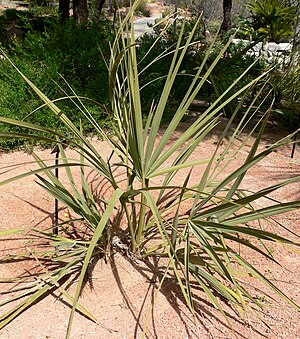Nannorrhops ritchiana
| Nannorrhops ritchiana | ||||||||||||
|---|---|---|---|---|---|---|---|---|---|---|---|---|

Nannorrhops ritchiana |
||||||||||||
| Systematics | ||||||||||||
|
||||||||||||
| Scientific name of the genus | ||||||||||||
| Nannorrhops | ||||||||||||
| Wendl. | ||||||||||||
| Scientific name of the species | ||||||||||||
| Nannorrhops ritchiana | ||||||||||||
| ( Handle. ) Aitch. |
Nannorrhops ritchiana or Mazari palm is a fan palm native to Arabia and the Middle East. It was the only species in the genus Nannorrhops . A second species of this genus was newly described in 2016.
features
Nannorrhops ritchiana is a bush-shaped, multi-stemmed, unreinforced palm. It blooms only once ( hapaxanth ), the individuals are hermaphroditic. The trunks are branched, prostrate or upright. They are largely underground, but can be up to 4.5 m high. Branching is axillary in prostrate specimens, dichotomous in erect stems. A fully grown specimen can be up to 6 m high and just as wide, but mostly they reach 1.8 m high and 2.4 m wide.
The number of chromosomes is 2n = 36.
leaves
The leaves are induplicate, costapalmat for short. They dry up on the plant. The leaf sheath tears both below and opposite the petiole. It is brown, with woolly hair. The petiole is long, slightly furrowed on the top and rounded on the underside. Hastulae are absent. The leaf blade is regularly divided into stiff, blue-green, simply folded segments. These are further subdivided by an abaxial crack that extends up to halfway.
Inflorescences
The inflorescences appear above the leaves, are compound and reach 1.8 m in length. The partial inflorescences correspond to the axillary inflorescences of multiple flowering palms. Each partial inflorescence begins in the axilla of a leaf with a reduced blade, or a tubular bract. The partial inflorescences are quadruple branched. The cover sheet is Roehrig and two-keeled. There are no or several bracts on the peduncle that resemble the previous leaf. The bracts for the side branches of the first order are tubular with a distinct tip. Each axis of the first order has a basal, tubular, double-keeled cover sheet. The bracts for the secondary branches of the second order are tubular. The flower-bearing axes have conspicuous tubular bracts, each with a group of flowers in their axils.
blossoms
The flowers have a short stalk and are in a shortened wrap of one to three (rarely up to seven) flowers, each flower has a small, tubular bract. The calyx is thin, tubular at the base and has three triangular lobes. The crown has a short stem-like base and three lobes klappig (in the lower two thirds valvat ), in the upper third imbricat stand. The six stamens are not fused. The three antesepals (standing in front of the sepals) have free stamens, the three antepetal (standing in front of the petals) are fused with the petals at the base. The stamens are awl-shaped, bent at the tip. The anthers are elongated, the anthers are latrors . The three carpels are fused, with the exception of the lowest part. The ovary is clearly three-furrowed. There is a single stylus , a scar is poorly differentiated. The ovule is anatropic and attaches to the abdomen and basal.
The pollen grains are ellipsoidal and mostly slightly asymmetrical. The germ opening is a distal sulcus . The Ectexine is tectat, reticulat or foveolat-reticulat. The edge of the germ opening is psilat (without ornamentation) or scabrat. The infratectum is columellate. The longest axis of the pollen grain measures 30 to 39 micrometers.
Fruits and seeds
The fruits are spherical to ellipsoidal. They contain a seed. The scar remains are basal. The exocarp is smooth, the mesocarp fleshy, and the endocarp thin. The seed is spherical to ovoid. It has shallow furrows that correspond to the bundles of rapes . The scar (hilum) is basal. The endosperm is homogeneous and usually has a small central cavity. The embryo is basal.
Distribution and locations
Nannorhops ritchiana is found in the semi-deserts of the Middle East: eastern Arabia, southern Iran, western Pakistan and southern Afghanistan. It grows in areas where the groundwater is not too deep: oases and episodic watercourses. However, it avoids subtropical coastal regions. It rises up to 1600 m above sea level.
Systematics
The genus Nannorrhops is placed within the palm family in the subfamily Coryphoideae and the tribe Chuniophoeniceae . Their position in relation to the other genus of the tribe has not yet been finally clarified. It contains only two types:
- Nannorrhops baluchestanica Khodash. : It was first described in 2016 from southeastern Iran.
- Nannorrhops ritchiana (Griff.) Aitch. : It occurs on the southern Arabian Peninsula and from Iran to Pakistan.
The generic name is made up of the ancient Greek words for dwarf and bush , so it relates to the growth habit. The species epithet refers to the collector of the material for the first description , Ritchie.
use
Fibers are obtained from the palm and are used for weaving pieces and ropes. It is one of the most cold-resistant palm species, but is rarely grown as an ornamental plant.
literature
- John Dransfield, Natalie W. Uhl, Conny B. Asmussen, William J. Baker, Madeline M. Harley, Carl E. Lewis: Genera Palmarum. The Evolution and Classification of Palms . Second edition, Royal Botanic Gardens, Kew 2008, ISBN 978-1-84246-182-2 , pp. 292-294.
Individual evidence
- ^ A b c d e Robert Lee Riffle, Paul Craft: An Encyclopedia of Cultivated Palms , 4th edition, Timber Press, Portland 2007, ISBN 978-0-88192-558-6 , p. 390.
- ↑ a b Rafaël Govaerts (Ed.): Nannorrhops. In: World Checklist of Selected Plant Families (WCSP) - The Board of Trustees of the Royal Botanic Gardens, Kew . Retrieved August 3, 2018.
Web links
- Nannorrhops on the homepage of the Fairchild Tropical Botanic Garden
